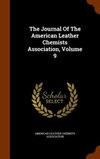清洁亚临界脱脂系统对羊毛纤维的影响
IF 0.5
4区 工程技术
Q4 CHEMISTRY, APPLIED
Journal of The American Leather Chemists Association
Pub Date : 2021-05-03
DOI:10.34314/jalca.v116i5.4292
引用次数: 0
摘要
在毛皮生产过程中采用环保的脱脂方法是有意义的。本研究采用亚临界正戊烷对羊毛纤维进行脱脂。采用热重分析(TGA)对亚临界正戊烷脱脂羊毛纤维的性能进行了观察和分析。结果表明,纤维的热稳定性有所提高。利用傅里叶变换红外光谱(FTIR)分析了羊毛纤维中大分子链的结构变化。实验发现,当压力大于0.4 MPa时,羊毛纤维发生构象变化,α-螺旋变为β-折叠。当压力高达0.6 MPa时,羊毛纤维结垢层中的二硫键出现断裂。采用x射线粉末衍射实验研究了羊毛纤维聚集形态的变化。结果表明,羊毛纤维结晶区发生变化,纤维指数由22.89%提高到30.19%。采用场发射扫描电镜和超深场显微镜分析了羊毛纤维表面形貌的变化。结果表明,处理后羊毛纤维未受到损伤,羊毛表面杂质减少。本文章由计算机程序翻译,如有差异,请以英文原文为准。
Effects of a Clean Subcritical Degreasing System on Wool Fibers
It makes sense to use environmentally friendly methods of degreasing in fur-making process. In this study, subcritical n-pentane was used to degrease wool fibers. Thermogravimetric analysis (TGA) was used to observe and analyze the properties of the subcritical n-pentane degreased wool fibers. The results showed that the thermal stability of the fibers increased. Fourier Transform Infrared (FTIR) spectroscopy was used to analyze the structural changes of macromolecular chains in wool fibers. It was found that when the pressure was higher than 0.4 MPa, the wool fibers underwent a conformational change with the α-helix changing to β-folding. If the pressure was as high as 0.6 MPa, the disulfide bonds in the wool fibers scale layer appeared to break. X-ray powder diffraction experiment was used to study changes in wool fiber aggregation morphology. It was demonstrated that the crystalline zone of wool fibers changed and the fibers index grew, from 22.89% to 30.19%. Field emission scanning electron microscopy and ultra-depth of field microscopy was used to analyze changes in the surface morphology of wool fibers. The results suggested that after the treatment, the wool fibers were not damaged and the impurities on the wool surface were reduced.
求助全文
通过发布文献求助,成功后即可免费获取论文全文。
去求助
来源期刊

Journal of The American Leather Chemists Association
工程技术-材料科学:纺织
CiteScore
1.30
自引率
33.30%
发文量
29
审稿时长
3 months
期刊介绍:
The Journal of the American Leather Chemists Association publishes manuscripts on all aspects of leather science, engineering, technology, and economics, and will consider related subjects that address concerns of the industry. Examples: hide/skin quality or utilization, leather production methods/equipment, tanning materials/leather chemicals, new and improved leathers, collagen studies, leather by-products, impacts of changes in leather products industries, process efficiency, sustainability, regulatory, safety, environmental, tannery waste management and industry economics.
 求助内容:
求助内容: 应助结果提醒方式:
应助结果提醒方式:


